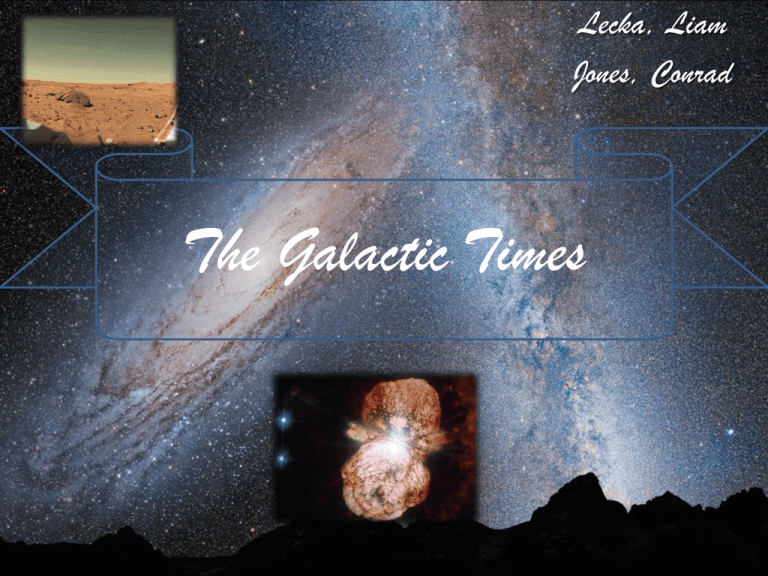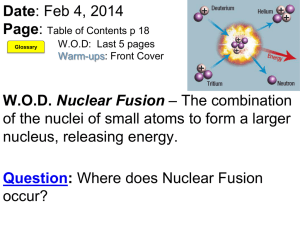
Lecka, Liam
Jones, Conrad
The Galactic Times
Table of Contents
1.) The Galactic Times
2.) Table of Contents
3.) “Nuclear Fusion Rocket Could Reach Mars in 30
Days”
4.) What is Nuclear Fusion?
5.) Nuclear Fusion Video!
6.) What’s so special about Mars?
7.) To Conclude…
8.) “First Biological Evidence of a Supernova”
9.) What are isotopes?
10.) What is a supernova?
11.) Magnetotactic Bacteria
12.) In Conclusion
13.) Bibliography
14.)Bibliography (continued)
“Nuclear Fusion Rocket Could
Reach Mars in 30 Days”
•
•
•
•
•
Manned-travel to Mars could be possible in the near future. A
group consisting of scientists at the University of Washington
and MSNW, a space-propulsion company, are developing a way to
decrease the time, money, and health risks associated with a
possible trip to Mars.
This plan would fuel the rocket through nuclear fusion. The
team is attempting to create nuclear fusion with a special type
of plasma by compressing it to an extremely high pressure
within a magnetic field.
This creates the material needed, and a single sand-grain piece
of it would house more energy than current rocket fuel.
Basically, for the rocket to be propelled, the magnetic field
would cause metal rings to collapse around the plasma,
compressing it to a fusion state for an instant. These quick
reactions would heat up and ionize the metal, which would shoot
out of the nozzle and propel the rocket.
With this new-found energy, a rocket could get to Mars in 30-90
days!
What is Nuclear Fusion?
• Nuclear fusion is the process in which a large nucleus is created from two
smaller nuclei combining.
• For this process to occur, extremely high temperatures are needed, as
plasma can only exist in them.
• Plasma is a state of matter where atoms are stripped of their electrons.
• In this process, as shown below, energy and a neutron are released. It
releases a large amount of energy, and fusion fuels the sun.
• If its energy can be harnessed, fusion could power the future.
Nuclear Fusion Video!
What’s so special about Mars?
• Mars is the most Earthlike of all planets.
• It could have contained life before, as well as water before
(landscape shape).
• It also has distinct seasons.
• However, it has a very thin atmosphere, so temperatures vary
greatly, from -140° to 20°C.
• In addition, not much else is known about the planet, and
since it housed life before, researchers would like to send
astronauts to explore the “red planet”.
To Conclude…
• Researchers are designing a way to get to
Mars in 30 days through nuclear fusion.
• To make nuclear fusion for propulsion
possible, the scientists need to combine the
isolated tests they’ve preformed and move on
to the actual fusion process.
• As one researcher states, “We hope we can
interest the world with the fact that fusion
isn't always 40 years away and doesn't always
cost $2 billion“(Slough).
“First Biological EvidEncE oF
a supErnova”
• Scientists at the Technische Universitaet Muenchen (Technical University of Munich, or
TUM), discovered Fe-60, an extremely old radioactive iron isotope, that came from a supernova
nearby in space.
• This discovery marks the first time scientists have ever found evidence of a supernova hitting
Earth.
• This supernova occurred about 2.2 million years ago.
• Fe-60 is only found as a result of a supernova.
• Researchers hypothesized that Fe-60 could be found in “magnetofossils”, which are created from
undersea bacteria that make microscopic crystals of iron.
What are isotopes?
• Isotopes are atoms of the same element with amounts of
neutrons, which in turn, creates different mass numbers.
• If you look at a periodic table, all of the isotopes that
exist for an element are weighted and averaged,
causing the mass numbers to never be whole numbers.
• Iron has an atomic number 26, therefore, Fe-60 contains
26 protons and 36 neutrons.
What is a supernova?
Magnetotactic Bacteria
• Magnetotactic Bacteria, or mtb, are a type of undersea bacteria that
live in ocean sediments.
• They migrate on magnetic field lines underwater in the sediment.
• Mtb contain magnetic mineral crystals called magnetosomes inside a
membrane. They are arranged in a chain structure.
• These crystals are oriented to act as a “compass needle” to guide the
mtb along the magnetic field lines.
• To get iron for the crystals, mtb absorb it from dust drifting in the
ocean. That’s how the fossils contained Fe-60.
In Conclusion
• The discovery of Fe-60 in magnetofossils aged between 1.7 and 3.3
million years reveals that the first supernova to contact Earth
occurred about 2.2 billion years ago.
• The research team from TUM are now going to analyze another
sediment drill core. This core has more than 10 times amount of
sediment of the first core.
• If the Fe-60 signal is found, the team will take the shape of the signal
and map it as a function of time.
• This graph depicts an overlay of the
gamma-ray signal of Fe-60 in the galaxy
Bibliography
•
•
•
•
•
•
•
•
•
•
Bell, Edwin V., Dr. "NSSDC Photo GalleryMars." NSSDC Photo Gallery: Mars. NASA, 10 Dec. 2010.
Web. 14 May 2013. <http://nssdc.gsfc.nasa.gov/photo_gallery/photogallery-mars.html>.
"Blast Off!" Rdesigno RSS. Wordpress, 21 Sept. 2010. Web. 14 May 2013.
<http://rdesigno.com/category/plan-improving/>.
Chen, Lijun. "Bacteria That Synthesize Nano-sized Compasses to Navigate Using Earth's
Geomagnetic Field." Nature.com. Nature Publishing Group, 2012. Web. 14 May 2013.
<http://www.nature.com/scitable/knowledge/library/bacteria-that-synthesize-nano-sizedcompasses-to-15669190>.
Elearnin. "Nuclear Fusion | Fusion Energy Explained with Hydrogen Atom Example | Physics
Animation Video." YouTube. YouTube, 06 May 2013. Web. 12 May 2013.
<http://www.youtube.com/watch?v=Cb8NX3HiS4U>.
"The Fabulous Life of Will G." : May 2010. Blogger, 19 May 2010. Web. 12 May 2013.
<http://pepsisipper.blogspot.com/2010_05_01_archive.html>.
"First Biological Evidence of a Supernova." ScienceDaily. ScienceDaily, 08 May 2013. Web. 14 May
2013. <http://www.sciencedaily.com/releases/2013/05/130508123022.htm>.
Frankel, Richard B. "Magnetotactic Bacteria at Cal Poly." Magnetotactic Bacteria at Cal Poly. Cal
Poly State University. Web. 14 May 2013. <http://www.calpoly.edu/~rfrankel/mtbcalpoly.html>.
Helmenstine, Todd. "How to Use a Periodic Table." About.com Chemistry. About.com. Web. 14 May
2013. <http://chemistry.about.com/od/periodictable/ss/How-To-Use-A-Periodic-Table.htm>.
"Image of the Day Gallery." NASA. Ed. Rebecca Goodman. NASA, 24 Feb. 2012. Web. 14 May 2013.
<http://www.nasa.gov/multimedia/imagegallery/image_feature_2183.html>.
Macaulay, David. "Brits in the USA." : Stars in the Sahara. Blogger, 22 Dec. 2010. Web. 14 May 2013.
<http://britsintheus23.blogspot.com/2010/12/stars-in-sahara.html>.
•
•
•
•
•
•
•
•
•
Bibliography (continued)
Memmott, Mark. "10-Year-Old Supernova Sleuth: 'I Didn't Want To Get My Hopes Too High'" NPR. NPR, 4 Jan.
2011. Web. 15 May 2013. <http://www.npr.org/blogs/thetwo-way/2011/01/04/132657406/10-year-oldsupernova-sleuth-i-didnt-want-to-get-my-hopes-too-high>.
Miles, Kathy. "The Great Martian Traffic Jam." The Great Martian Traffic Jam. 2008. Web. 15 May 2013.
<http://starryskies.com/articles/2003/04/mars.html>.
"NASA - National Aeronautics and Space Administration." NASA. Ed. Robert Garner. NASA, 31 May 2012. Web. 9
May 2013. <http://www.nasa.gov/mission_pages/hubble/science/milky-way-collide.html>.
"Nuclear Fusion Rocket Could Reach Mars in 30 Days." Space.com. TechMediaNetwork.com, 10 Apr. 2013. Web. 9
May 2013. <http://www.space.com/20609-nuclear-fusion-rocket-mars.html>.
PBSNewsHour. "Harvard Astrophysicist Answers: What Is a Supernova?" YouTube. YouTube, 12 Nov. 2010. Web. 12
May 2013. <http://www.youtube.com/watch?v=zMgsn_nJKM0>.
Wysession, Michael, David V. Frank, and Sophia Yancopoulos. Prentice Hall physical science: concepts in action
with earth and space science. Upper Saddle River, N.J.: Pearson/Prentice Hall, 2006. Print.
"Radioactive Iron, a Window to the Stars." MPE. Max-Planck-Institut Für Extraterrestrische Physik, 26 June 2007.
Web. 14 May 2013. <http://www2011.mpe.mpg.de/gamma/highlights.html>.
ScaredCrows. "Supernova Explosion Simulation." YouTube. YouTube, 26 May 2007. Web. 14 May 2013.
<http://www.youtube.com/watch?v=jHjTb8Chq3k>.
"Supernova Explosion." Free Wallpapers. Web. 12 May 2013. <http://fwallpapers.com/view/supernovaexplosion>.




